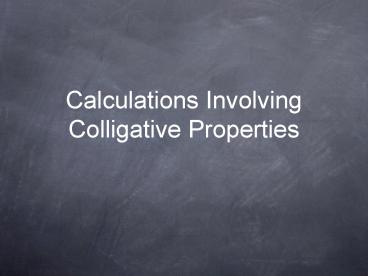Calculations Involving Colligative Properties - PowerPoint PPT Presentation
1 / 18
Title:
Calculations Involving Colligative Properties
Description:
Introduction We now understand colligative properties. To use this knowledge, we need to be able to predict these colligative properties. Freezing Point Depression ... – PowerPoint PPT presentation
Number of Views:85
Avg rating:3.0/5.0
Title: Calculations Involving Colligative Properties
1
Calculations Involving Colligative Properties
2
Introduction
- We now understand colligative properties.
- To use this knowledge, we need to be able to
predict these colligative properties. - Freezing Point Depression
- Boiling Point Elevation
3
Introduction
- We also need to use a different kind of
concentration determination. - Instead of molarity, we will use
- molality, m
- mole fraction, X
4
Molality
- Molarity - we measure the number of mols of
solute in the volume of the solution. - Msolution nsolute/Vsolution
- Molality - we measure the number of mols of
solute in the mass of solvent. - msolution nsolute/msolvent
5
Molality
- msolution nsolute/msolvent
- The mass of the solvent is measured in kilograms,
kg. - 1 mole of solute in
- 1,000 g of solvent gives
- a 1 m solution.
6
Molality
Example 1
Find the molality of 87.66 g of sodium chloride
dissolved in 2.500 kg of water.
mNaCl 87.66 g mH2O 2.500 kg MNaCl 58.44
g/mol
m nNaCl/mH2O
1.500 mol/2.500 kg
m 0.600 mol/kg
nNaCl mNaCl/MNaCl
87.66 g/58.44 g/mol
nNaCl 1.500 mol
7
Molality
Example 2
How many grams of potassium iodide must be
dissolved in 500.0 g of water to produce a 0.060
molal KI solution?
msolution 0.060 m mH2O 500.0 g 0.5000
kg MKI 166.0 g/mol
m nKI/mH2O
nKI m x mH2O
(0.060)(0.5000) mol
nKI 0.030 mol
mKI nKI x MKI
(0.030)(166.0) g
5.0 g
8
Mole Fraction
- Mole Fraction is the ratio of number of mols of
the solute to the total number of mols of the
solute plus the solvent. - We use the symbol X to represent the mole
fraction. - Xsolute
nsolute
nsolute nsolvent
9
Mole Fraction
Example 3
Ethylene glycol, C2H6O2, is added to automobile
cooling systems to protect against cold weather.
What is the mole fraction of each component in a
solution containing 1.25 mols of ethylene glycol
(EG) and 4.00 mol of water?
nEG 1.25 mol nH2O 4.00 mol
nEG
1.25 mol
XEG
0.238
nEG nH2O
1.25 mol 4.00 mol
nH2O
4.00 mol
XH2O
0.762
nEG nH2O
1.25 mol 4.00 mol
10
Colligative Calculations
- The magnitudes of freezing point depression (?Tf)
and boiling point elevation (?Tb) are - directly proportional to the molal concentration
of the solute, - if the solute is molecular and not ionic.
11
Colligative Calculations
- The magnitudes of freezing point depression (?Tf)
and boiling point elevation (?Tb) are - directly proportional to the molal concentration
of all ions in solution, - if the solute is ionic.
12
Colligative Calculations
- ?Tf Kf x m
- where
- ?Tf is the freezing point depression of the
solution - Kf is the molal freezing point constant for the
solvent. - m is the molal concentration of the solution
13
Colligative Calculations
- ?Tb Kb x m
- where
- ?Tb is the boiling point elevation of the
solution - Kb is the molal boiling point constant for the
solvent. - m is the molal concentration of the solution
14
Colligative Calculations
Example 4
What is the freezing point depression of a
benzene (C6H6, BZ) solution containing 400 g of
benzene and 200 g of the compound acetone (C3H6O,
AC). Kf for benzene is 5.12C/m.
mAC
200 g
mBZ 400 g 0.400 kg mAC 200 g MAC 58.0
g/mol Kf 5.12C/m
nAC
MAC
58.0 g/mol
3.45 mol
nAC
nAC
3.45 mol
m
8.62 m
mBZ
0.400 kg
?Tf Kf x m
(5.12C/m)(8.62 m)
44.1C
15
Colligative Calculations
Example 5
What is the boiling point of a 1.50 m NaCl
solution?
m 1.50 m Kb 0.512C/m Tb 100.0C
NaCl produces 2 mols of particles for each mol of
salt added m 2(1.50 m) 3.00 m
?Tb Kb x m
(0.512C/m)(3.00 m)
1.54C
T Tb ?Tb
100.0C 1.54C
101.5C
16
Summary
- Molality - we measure the number of mols of
solute in the mass of solvent. - msolution nsolute/msolvent
- The mass of the solvent is measured in kilograms,
kg.
17
Summary
- Mole Fraction is the ratio of number of mols of
the solute to the total number of mols of the
solute plus the solvent. - We use the symbol X to represent the mole
fraction. - Xsolute
nsolute
nsolute nsolvent
18
Summary
- ?Tf Kf x m ?Tf is the freezing point
depression of the solution, Kf is the molal
freezing point constant for the solute, and m is
the molal concentration of the solution. - ?Tb Kb x m ?Tb is the boiling point elevation
of the solution, Kb is the molal boiling point
constant for the solute, and m is the molal
concentration of the solution.































